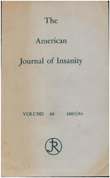Body dysmorphic disorder in patients with anxiety disorders and major depression: a comorbidity study
Abstract
OBJECTIVE: The authors evaluated the frequency of body dysmorphic disorder in patients with a primary diagnosis of anxiety disorders and major depression. METHOD: Patients with social phobia (N = 54), obsessive-compulsive disorder (N = 53), generalized anxiety disorder (N = 32), panic disorder (N = 47), and major depression (N = 42) and normal comparison subjects (N = 33) were studied. RESULTS: Body dysmorphic disorder was most common in patients with social phobia (11%) and obsessive-compulsive disorder (8%); it was less prevalent among patients with panic disorder (2%), generalized anxiety disorder (0%), and major depression (0%) and among normal subjects (0%). CONCLUSIONS: These findings suggest that body dysmorphic disorder may share etiologic elements with social phobia and obsessive-compulsive disorder.
Access content
To read the fulltext, please use one of the options below to sign in or purchase access.- Personal login
- Institutional Login
- Sign in via OpenAthens
- Register for access
-
Please login/register if you wish to pair your device and check access availability.
Not a subscriber?
PsychiatryOnline subscription options offer access to the DSM-5 library, books, journals, CME, and patient resources. This all-in-one virtual library provides psychiatrists and mental health professionals with key resources for diagnosis, treatment, research, and professional development.
Need more help? PsychiatryOnline Customer Service may be reached by emailing [email protected] or by calling 800-368-5777 (in the U.S.) or 703-907-7322 (outside the U.S.).



